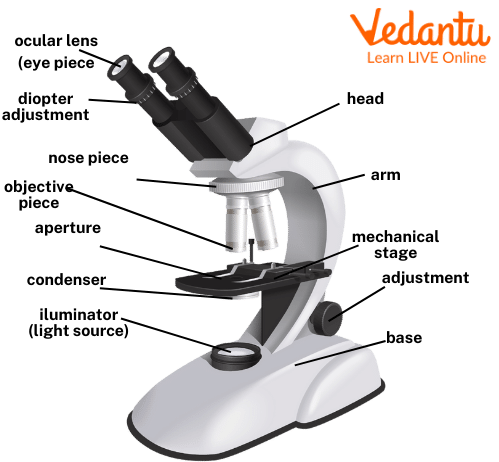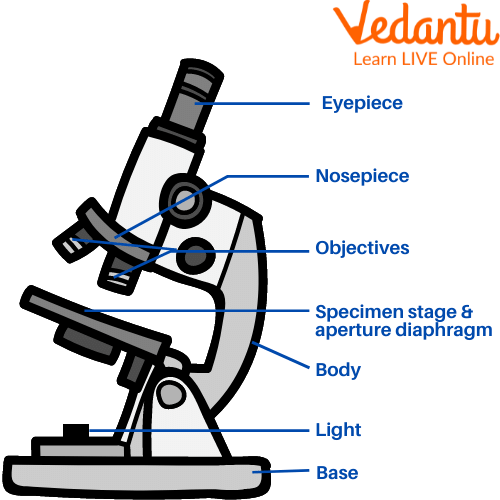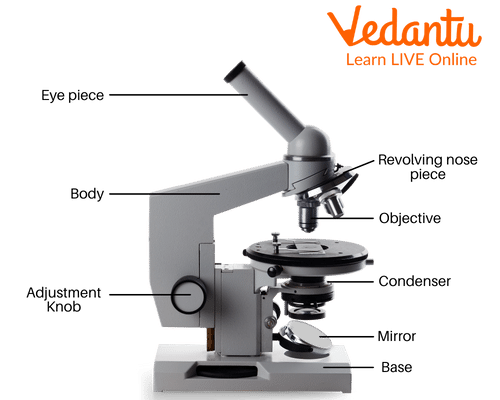




Introduction to Microscope Working
Kids, have you seen the microscope? Do you know how this instrument works?
We are going to learn all these in this article.
First, let us see what the microscope is and how it works.
The microscope is an instrument that can be used to see and observe every small object that is not able to be seen by the naked eye, such as cells. The image of any kind of object is magnified by at least one lens in the microscope. This lens bends the light toward the eye and makes an object appear larger than it is.
How Does a Microscope Work?
The microscope works on the principle of a Simple Microscope. The working principle of a microscope is that when any sample is placed within the focus of the microscope, a virtual, erect and magnified image is then produced at the least distance of distinct vision from the eye that is kept at the lens.
Working Principle of Microscope
The Optical Microscope Working Principle:
The optical microscope makes a magnified image of an object specimen with the objective lens. Further, it magnifies the image with an eyepiece to allow the user to observe it with the help of the naked eye. Sometimes the optical microscope, also known as a light microscope, uses one or more than one lens to magnify images of small samples with visible light.

Different Parts of the Microscope
The Working Principle of the Compound Microscope
The term compound refers to using more than one lens in the microscope. In the compound microscope, more than one lens is used for a better view of objects. However, the compound microscope is one of the types of the optical microscope.
The compound microscope contains two lenses. The lens placed towards the object is called the objective lens, and the lens placed nearer the eye is called the eyepiece.
Different Types of Microscope
The Microscope is of Different Types:
Simple Microscope: The simple microscope is defined as a magnifying glass with a double convex lens that has a short focal length. The simple microscope is used in microbiology labs to study the samples of algae, fungi etc. It is also used by the jewellers to get a magnified image of the fine parts of the jewellery.

Image showing Simple Microscope
Compound Microscope: The compound is defined as the microscope with a high resolution and it uses two sets of lenses and gives a 2-dimensional image of the sample. The compound microscope is used by the forensic department to detect the human fingerprints. It is also used in schools for academic purposes.

Image showing Compound Microscope
Amazing Facts about Microscope
Microscope is an instrument that is used to see a small object or by magnifying it.
If there is a single lens used in a microscope then it is called a simple microscope.
If two lenses are used in a microscope then it is called compound microscope.
The lens placed closer to the eye is called eyepiece while the lens placed at the other end is called objective.
The microscope has been used for the last 3,000 years in various forms.
The very first microscope was made to study insects.
Through multiplying the power of the respective objective lenses, the microscope gets its magnifying power.
The object can be magnified thousands of times if it is viewed through an electron microscope.
The first single lens microscope was made in the 1600s and it can magnify the objects 200 times.
The ability to see objects clearly and separately is known as resolution of that microscopic lens.
Under the microscope if any object is photographed, then it is called a micrograph.
The smallest object seen under the microscope was 500 nanometer long.

Kid Observing the Microscope
Summary
We learned that the microscope is an instrument that can be used to see and observe every small object that is not able to be seen by the naked eye, such as cells. Sometimes the optical microscope, also known as a light microscope, uses one or more than one lens to magnify images of small samples with visible light. The lenses are kept between the sample and the observer’s eye to magnify the image so that it can be examined in detail. The optical microscope works on the principle of reflection of light.
FAQs on How Does a Microscope Work ?
1. How does a simple microscope work to make things look bigger?
A simple microscope works much like a magnifying glass. It uses a single convex lens to bend light rays that pass through it. When you look at a tiny object through this lens, the bent light tricks your eyes into seeing a much larger, upright image of the object. This process is called magnification.
2. What are the main parts of a compound microscope used in a school lab?
A compound microscope has several important parts that work together. The main ones are:
- Eyepiece: The part you look through at the top. It has a lens that magnifies the image from the objective lens.
- Objective Lenses: These are the lenses closest to the object. There are usually three or four, each with a different power of magnification.
- Stage: A flat platform where you place the slide with the specimen you want to view.
- Illuminator: A light source at the base that shines light up through the specimen to make it visible.
- Focus Knobs: These are used to move the stage or objective lenses up and down to get a sharp, clear image.
3. What is the main difference between a simple microscope and a compound microscope?
The main difference lies in the number of lenses and their magnifying power. A simple microscope uses only one lens to magnify an object, providing lower magnification. A compound microscope uses two or more sets of lenses (the eyepiece and objective lenses) to achieve much higher and more detailed magnification, allowing us to see things as small as cells.
4. Why are microscopes considered one of the most important tools in science?
Microscopes are crucial because they allow us to see a hidden world that is too small for our naked eyes. Without them, we would not have discovered cells, which are the basic building blocks of all life. Scientists use microscopes to study bacteria and viruses, understand diseases, develop new medicines, and examine the detailed structures of everything from plants to rocks.
5. What are some everyday things that look completely different and amazing under a microscope?
Many common items reveal incredible details under a microscope. For example, a grain of salt looks like a perfectly shaped crystal cube. A single strand of hair shows complex layers and textures. A drop of pond water can reveal a whole ecosystem of tiny living creatures. Looking at these things helps us appreciate the complexity in the world around us.
6. If more lenses make things bigger, why can't we just keep adding lenses to see smaller and smaller things?
This is a great question! While adding lenses increases magnification, there is a limit. After a certain point, the image doesn't get clearer, it just becomes bigger and blurrier. This is because of a limit called resolution, which is the ability to see two close-together points as separate. For standard light microscopes, the properties of light itself create this limit. To see even smaller things, scientists must use different types of microscopes, like electron microscopes.
7. Are there types of microscopes even more powerful than light microscopes?
Yes, there are much more powerful microscopes. The electron microscope is a major example. Instead of using light to view an object, it uses a beam of tiny particles called electrons. This allows scientists to see objects that are thousands of times smaller than what a light microscope can show, such as the detailed structure of a virus or a single molecule.









